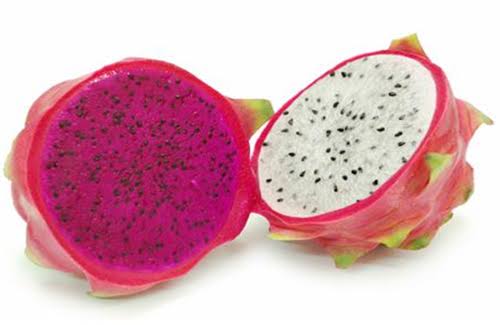Welcome to the land of Dragon Fruit, where two enthralling kinds reign supreme: Red Dragon Fruit and White Dragon Fruit.
You will come across these exotic fruits with their gorgeous beauty and unique flavor as we tour the details.
This review will further explore the main distinctions between the two species. Check out this summary to learn about the differences between the red and yellow types.
If you want to understand more about the various types of this tropical fruit, then keep reading as we go into nitty gritties.
Red Dragon Fruit
Red dragon fruit contains spherical fruit, ears that are bent towards the fruit stalk, and most fruit is red. On the other hand, the white flesh dragon fruit has an oval form, large ears, and is generally green.
We will be able to tell the difference when chopping dragon fruit. Inside the red-meat dragon fruit is dark crimson flesh that progressively turns dark purple. The meat of white flesh dragon fruit is plain white, with visible seeds.
The flesh is thick, semi-firm, and delicate, with an aqueous feel contrasting with the crunchy, chewy seeds to give a texture similar to kiwi fruit.
Nutritional Value
- Red dragon fruit has around 60 calories per fruit and is high in vitamins C, B1, B2, and B3 and minerals, including iron, calcium, and phosphorus.
- 100g of fruit contains roughly 21 mg of vitamin C, comparable to 34% of the daily intake.
- A quick comparison indicates that dragon fruit has less than half the vitamin C in oranges but is more than three times the size of carrots.
Cultivation And Growing
- Dragon fruits are native to Mexico and Central America and have been cultivated since prehistoric times.
- The fruits originated in the Caribbean, West Indies, and South America and flourished in tropical, subtropical, and semi-arid regions.
- Dragon fruit was first brought to Southeast Asia in the early 1800s and was formerly reserved for aristocratic families and monarchies.
- After being produced professionally for popular use, the plants eventually moved to the Middle East and Australia. Red Dragon fruits were also imported to Hawaii in 1830.
White Dragon Fruit
The tropical white dragon fruit is produced in Southeast Asia, Central and South America, Mexico, and Israel. Pitaya is another name for strawberry pear. It has a sweet and crispy flavor.
Though it may appear unusual at first glance, cutting and cooking this wonderful fruit is really simple. It is a nutritious fruit that may also be used in salads, beverages, and desserts. There are three types of dragon fruit.
The White meat Dragon Fruit features pink skin and white meat. The crimson Dragon Fruit features pink skin and crimson meat. The final one has yellow skin and is known as Yellow Dragon Fruit. The white flesh dragon fruit is the most frequent type of dragon fruit.
Nutritional Value
- Dragon fruit is abundant in iron, magnesium, B vitamins, phosphorus, protein, calcium, and fiber and contains around 80% water.
- The fruit's edible seeds are also high in polyunsaturated fats like omega-3 and omega-6 fatty acids, which have been shown to lower the risk of cardiovascular disease.
Also read: Top 10 High Vibrational Foods: A Comprehensive Guide
Cultivation And Growing
Although the exact native range of dragon fruit is unknown, it is considered native to Central America, spanning from southern Mexico through Belize, Guatemala, El Salvador, and Costa Rica.
This is partly owing to the fruit's long history of cultivation, but it has also been known to escape cultivation and become naturalized.
Nonetheless, dragon fruit was discovered centuries ago in Central America and spread worldwide by early missionaries and explorers, including Australia, the Middle East, and parts of Asia.
Key Differences Between Red And White Dragon Fruit
This exotic fruit comes in two varieties: red dragon fruit and white dragon fruit. While they may appear the same on the surface, some significant distinctions exist between these two dragon fruit species.
Visual Difference
Scales
The curving scales or ears of red dragon fruit and pink and purple dragon fruit are small triangles on the fruit body. They are green in color and thicker. Red fruit is also narrower, darker, and contains more scales than white fruit.
Plants
The red variety's flower tips are brighter than the white variety's. The white variant occasionally features white or yellow blossom tips. Both types of flowers are aromatic.
Nutritional Value
The applications and advantages of dragon fruit are numerous. It is well known that dark red fruits and vegetables contain more antioxidants. As a result, red dragon fruit contains more antioxidants than white dragon fruit.
This makes it an excellent diet for maintaining healthy eyes, blood, and skin. The crimson type is often utilized to produce delectable wine.
However, the red one has more sugar than the white one. If you have diabetes, you should eat white dragon fruit.
Many people like red fruit because of its great sweetness. Dragon S8 is a delicious variety. There is one exception: Ecuador Palora, a white variant that has been considered to be the tastiest kind of dragon fruit. BRIX sugar score is 23, and other varieties stand at 15.
Also read: Debunking 5 Common Myths about Food and Nutrition
Flavor Profile
Dragon fruit has a pleasant sweetness and is regarded as a cross between kiwi and pear flavors. It may be used to make various delectable drinks and foods, including dragon fruit smoothies, dragon fruit juice, dragon fruit tea, dragon fruit cake, dragon fruit jam, and so on.
Culinary Uses
One of the noteworthy applications of fruits is the making of wine. Grapes are well-known for their capacity to generate a broad range of wines, but wine may also be created from other fruits.
The wine-producing dragon fruit variety is unquestionably Selenicereus costaricensis, which is the scientific name for the red variation. The winemaking process is somewhat dissimilar to how grapes are processed.
While regular white' dragon fruit wine does exist, red dragon fruit wine is more prevalent and generally more well-liked. This is due to the distinct, concentrated flavors rather than the color similarity to red wine.
Which Dragon Fruit Should You Choose?
Red dragon fruit has several health advantages due to its high nutritional content:
- Good blood sugar control
- Lower your cholesterol
- It gives the body fat and protein.
- Antioxidant-rich, skin-beneficial
- Arthritis prevention
- Improve your heart health.
Or Choose Based On Taste Profile
When selecting red dragon fruit, we should consider freshness, if the stem is wilted, and whether the color is fresh. The more succulent and fresh the dragon fruit, the more wonderful it is.
There is a yellow dragon fruit in addition to the red dragon fruit. The flavor is slightly sweeter than the previous two, and the fruit is golden.
Conclusion
Despite differences in flavor, appearance, and nutritional content, we observed that both fruits provide exceptional health benefits and a touch of unique appeal to any culinary experience.
Whether you like the vibrant crimson hues of the crimson Dragon Fruit or the pure beauty of the White Dragon Fruit, these fruits will delight your palette and nourish your body. Accept Dragon Fruit's originality and appreciate its many flavor, knowing that each species brings its own distinct flavor to the table.
Take advantage of the opportunity to taste the finest of both worlds the next time you come across these beautiful fruits!

























